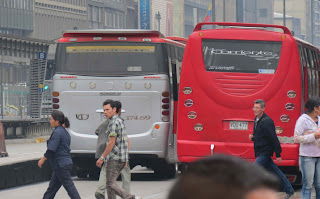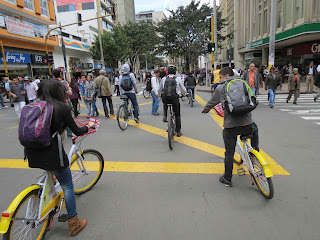 |
| Max Heinz and his guitar. |
 Max Heinz's mother fled Germany just before World War II "on the last boat out." She wasn't Jewish, but her father "knew that Germany was going to lose the war" and wanted to rescue his daughter. A man of influence and connections, Max Heinz's grandfather also knew of the Nazis' abuses against Jews and others committed in the notorious Dachau concentration camp. He was able to free a Jewish man from Dachau and help his family escape Germany - but on the condition that they adopted his daughter, Max Heinz's mother. "He put them on the boat, with my mother as their daughter." That's how Max Heinz obtained his Jewish surname Loeb, "although I'm not of Jewish blood."
Max Heinz's mother fled Germany just before World War II "on the last boat out." She wasn't Jewish, but her father "knew that Germany was going to lose the war" and wanted to rescue his daughter. A man of influence and connections, Max Heinz's grandfather also knew of the Nazis' abuses against Jews and others committed in the notorious Dachau concentration camp. He was able to free a Jewish man from Dachau and help his family escape Germany - but on the condition that they adopted his daughter, Max Heinz's mother. "He put them on the boat, with my mother as their daughter." That's how Max Heinz obtained his Jewish surname Loeb, "although I'm not of Jewish blood."The family landed in Buenaventura. Eventually, Max Heinz's mother met and married a Chilean man, who took her to his homeland, where Max Heinz was born. The Chilean's own father was from Birmingham, Alabama. His parents spoke to him in English and German, and "I learned Spanish from the drivers and gardeners," Max Heinz recalls. The family returned to Colombia, where Max Heinz's father worked as a translator.
 |
| By his home on the edge of the San Bernardino neighborhood. |
"I said 'What the fuck! and I went out to the street to drink."
Max Heinz, now 54, lived first in El Cartucho, the notorious neighborhood since bulldozed and replaced by Parque Tercer Milenium, then in El Bronx and now in the equally rough San Bernardino neighborhood just south of Tercer Milenio.
He's witnessed killings committed according to those neighborhoods' pitiless codes of justice. Back in El Cartucho, where he recalls 3, 4 or 5 murders took place every day, the bosses, known as caciques, would hand a man a gun and order him to kill someone.
"If he did it, he'd get twenty bazuco cigarretes, if not he'd get killed himself. He had to do it."
 |
| Waiting to sing on a bus on Carrera Decima. |
In the Bronx, he describes how drug sellers' ruthlessness with debtors. "They'll make the guy sit down, and give him an hour to pay. He can't go anywhere. All he can do is hope that someone who passes by will give him the money. Otherwise, they kill him."
Max Heinz, who seems quite a humanist, accepts this way of doing business.
"The dealers have to do it. Otherwise, the users would all take advantage of them.
 "There's a code of honor."
"There's a code of honor."Recently, he witnessed another musician gun a man down in San Bernardino. The corpse was tossed near a road. Nobody said anything. "Everybody is death, dumb and blind," says Max Heinz. The killer "must have had his reason. People don't kill for no reason."
He defends and respects El Bronx, even insisting that prostitution doesn't go on either there or the old Cartucho (against all other accounts I've heard), and that "women, children and animals are respected.
 |
| A street in the San Bernardino neighborhood. |
He consumes a cocktail of drugs himself, legal and illegal. But, as he describes it, they serve him as stimulants, keep him awake and enable him to play music. Just a few bits here and there, mixed into something else, he describes. One drug helps him control his consumption of another. He's got his self-maintenance formulas down pat, he says.
That was especially true back when he lived in El Bronx, where "they blasted the music until 6 a.m., shut down for a bit, and then started again."
 |
| Teaching English in La Candelaria. |
Still, his almost frenzied grin and rachety movements and speech give away that he's under the influence of something - or needs something.
For the past few months he's taught English in a foundation for poor children in La Candelaria. He credits that experience with helping him reduce the consumption of the one drug which he says was hurting him - vodka.
"I've cut down from two bottles a day to a half a bottle."
Along the way, Max Heinz has been profiled in the now-defunct 'Colombian Post,' which called him 'A Minstrel of Bogotá' and a few years ago in Cromos magazine, which baptized him a 'Poet of the Bronx.' He carries the article proudly in his pocket. Max Heinz says he's lived with six women and fathered nine children.
 |
| With students of English. |
And he earns his bread and butter singing on public buses. He's written 118 songs, but says that evangelical churches have stolen some of them. On buses, only fast ballads will do - he's got only a few minutes for his show, and a bolero would put the passengers to sleep.
"I've got to get on and do my show in two minutes and thirty seconds. I don't beg. I don't talk shit.
"I prefer singing to the poor. They give you coins and shake your hand. The rich just reach out and drop the coins into your hand."
But singing to bus passengers isn't easy: "They're tired. They've had a bad day. And they didn't ask you to sing. You've got to sing well. Otherwise, you make better money just begging."
But Max Heinz declined to sing for me. His guitar strings needed changing, he said.
By Mike Ceaser, of Bogotá Bike Tours












.jpg)






































